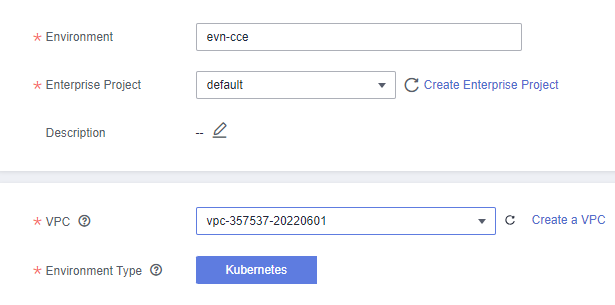Creating an Environment
Create an environment before deploying components.
Procedure
- Log in to ServiceStage.
- Choose Environment Management > Create Environment and configure the environment. Parameters marked with an asterisk (*) are mandatory.
Parameter
Description
*Environment
Environment name.
*Enterprise Project
Enterprise project.
Enterprise projects let you manage cloud resources and users by project.
It is available after you create an enterprise project.
Description
Environment description.
- Click
 and enter the environment description.
and enter the environment description. - Click
 to save the description.
to save the description.
*VPC
VPC where the environment resources are located.
For details about how to create a VPC, see Creating a VPC.
NOTE:After the environment is created, the VPC cannot be modified during Modifying an Environment.
*Environment Type
Environment type.
Kubernetes: applicable to container-based deployment (CCE). Components are deployed using container images and scheduled by Kubernetes.
NOTE:For details about the component deployment mode, see Deploying a Component.
Figure 1 Configuring an environment
- Click
- Click Create Now.
After the environment is created, go to the environment details page to view the environment details and configure environment resources.

If CCE clusters and VMs are managed in an earlier version, the environment type is VM + Kubernetes after the upgrade to the current version.
Follow-Up Operations
- After a Kubernetes environment is created, bind a CCE cluster to the environment before using the environment to deploy components. For details, see CCE Resource Management.
- After an environment is created, the compute resources (excluding CCE clusters), network resources, and middleware need to be managed together to form an environment. For details, see Managing Resources.
Feedback
Was this page helpful?
Provide feedbackThank you very much for your feedback. We will continue working to improve the documentation.See the reply and handling status in My Cloud VOC.
For any further questions, feel free to contact us through the chatbot.
Chatbot





